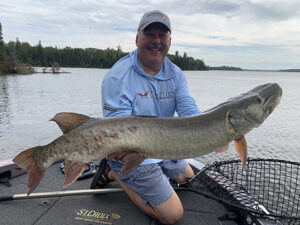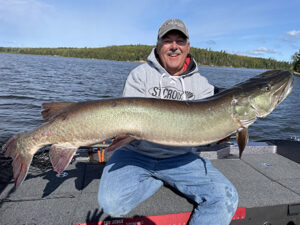By Steve Heiting
One of the great mysteries in musky fishing is where to find them, or at least where to find the fish that will bite today. Should we fish hard structure or soft? The reality is there is no simple answer that will apply to every day — where you should fish varies with the day and the season.
Structure as defined in fishing lexicon is the bottom of the lake that doesn’t change, like breaklines and rocks. “Cover” on the other hand, is the stuff that changes or disappears with time, such as weeds, fallen trees, manmade cribs, etc. All fish species use structure and/or cover at some point every year.

Since most musky anglers fish during the warmer water months, let’s discuss June through early September when water temperatures are typically in the mid 60s and up. This period will stretch from post-spawn until pre-turnover.
Once a musky finishes spawning, it won’t move far. The classic spawning spot is a shallow, protected bay on the lake’s north side, often with an incoming stream, where they deposit their eggs over last year’s dead weeds or sunken wood atop a mucky or sandy bottom. Since other fish species spawn in these same areas, post-spawn muskies will use any structure or cover located between where they spawned and what will be their main lake, summer haunts. Such in-between spots are called “transition areas.” Water temperature dictates their aggressiveness and, often, their exact location. If the shallows are warming, muskies will be feeding in soft cover like emerging weeds and fallen trees. However, if it’s early in the morning or you’re fishing on a cool day, muskies will usually be on hard bottom, outside the weeds and wood.
When fishing for muskies in transition, I continue casting smallish bucktails, minnowbaits and jerkbaits until I hear other fishermen complain of muskies grabbing the walleyes they’re fighting to the boat. At that point, I switch to larger lures.
Telemetry studies have shown that individual muskies have a home range they will use through summer, and it will usually contain both soft cover and hard structure. As water temperatures rise through the 60s and into the low 70s, many muskies will use weedbeds where they’ll find cover, baitfish, and warmth on sunny days. This is the classic “summer” bite during which any large lure that can be worked over, along and through the weeds could work.
As water temperatures rise into the mid 70s and above, you’ll need to fish deeper in the weeds, usually along the outside edge. Some muskies will go directly from spawning to suspending over deeper water, and will remain there through the summer months. Lakes with ciscoes, whitefish or shad tend to have a more consistent suspended bite, but even if your lake has only panfish and suckers as a forage base they will be targeted when in deep water by muskies.
There are many ways to find suspended muskies, but two of the best are to look for “soft structure” such as suspended baitfish, or by looking to hard structure such as breaklines, above which they will suspend. Muskies will also suspend over sunken trees or deep rocks, even 40 or 50 feet below them, though I have no idea how they locate them. Whether you cast or troll for suspended muskies depends on your preference. A caster using large crankbaits and soft plastics can be deadly because he can impart more action to his lures than can a troller. On the other hand, a troller covers more water. Perhaps the best approach is to troll until you find suspended baitfish and then pick the area apart by casting. Active, suspended muskies are usually within 15 feet of the surface, so keep your baits relatively shallow.

Wind matters when choosing to fish soft cover or hard structure. Many anglers simply love to drift over weedbeds and cast. Wind can also provide great fishing on hard structure in summer as it moves water and activates the food chain. If your favorite lake contains areas with shallow rocks, be sure to fish them with large lures that stand out in the chaos created by a stiff wind. This is not a time for finesse.
On sunny, post-frontal, bluebird days, which are typically tough for fishing, I often avoid wind and instead pick apart thick, protected weedbeds, which capture solar heat and may produce a brief burst of feeding activity. Some of my biggest muskies are caught with this pattern.
In late summer, evenings start cooling and water temperature drops ahead of turnover. I don’t know if every musky in a lake will move shallow at this time, but I do know the most active fish will be shallow as the water falls through the 60s into the upper 50s. In a dark water lake you may wish to limit yourself to spots that are six feet deep and less, whereas in a clear lake you probably want your boat over water no deeper than 12 feet. Sandy bottom areas can be great in the early morning following a cool night. Weeds remain good as long as they’re green. The more weeds deteriorate the less muskies will use them, and this change can happen overnight. If you’ve been finding pre-turnover muskies in the weeds and they suddenly seem to disappear, check the nearest rock structure because the fish may have moved there. Another time to fish shallow rocks in the pre-turnover period is in a stiff wind. Shorelines with broken, “chunk” rock can be fantastic.
There are no rules as to when you must fish hard structure or soft. Muskies’ lives are largely governed by water temperature, so to succeed you need to check the most likely spots as outlined here.
